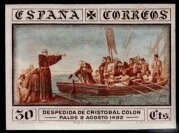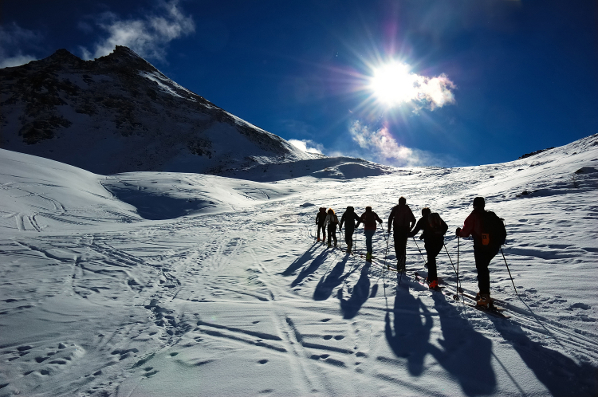Stamp: Discovery of America (Spain 1930)
Discovery of America (Spain 1930)
29 September (Spain ) within release Discovery of America goes into circulation Stamp Discovery of America face value 30 Spanish céntimo
| Stamp Discovery of America in catalogues | |
|---|---|
| Michel: | Mi: ES 511U |
| Edifil: | Edi: ES 540s |
| Unificato: | Un: ES 451nd |
Stamp is square format.
Also in the issue Discovery of America:
- Stamp - Discovery of America face value 1;
- Stamp - Discovery of America face value 4;
- Stamp - Discovery of America face value 20;
- Stamp - Discovery of America face value 5;
- Stamp - Discovery of America face value 10;
- Stamp - Discovery of America face value 25;
- Stamp - Discovery of America face value 50;
- Stamp - Discovery of America face value 10;
- Stamp - Discovery of America face value 10;
- Stamp - Discovery of America face value 10;
- Stamp - Discovery of America face value 25;
- Stamp - Discovery of America face value 50;
- Stamp - Discovery of America face value 50;
- Stamp - Discovery of America face value 1;
- Stamp - Discovery of America face value 4;
- Stamp - Discovery of America face value 10;
- Stamp - Monastère de la Rabida face value 5;
- Stamp - Discovery of America face value 1;
- Stamp - Discovery of America face value 1;
- Stamp - Discovery of America face value 2;
- Stamp - Discovery of America face value 2;
- Stamp - Discovery of America face value 5;
- Stamp - Discovery of America face value 5;
- Stamp - Discovery of America face value 10;
- Stamp - Discovery of America face value 15;
- Stamp - Discovery of America face value 20;
- Stamp - Discovery of America face value 20;
- Stamp - Discovery of America face value 25;
- Stamp - Discovery of America face value 30;
- Stamp - Discovery of America face value 30;
- Stamp - Discovery of America face value 1;
- Stamp - Discovery of America face value 1;
- Stamp - Discovery of America face value 4;
- Stamp - Discovery of America face value 4;
- Stamp - Discovery of America face value 10;
- Stamp - Discovery of America face value 10;
- Stamp - Discovery of America face value 1;
- Stamp - Discovery of America face value 1;
- Stamp - Discovery of America face value 4;
- Stamp - Discovery of America face value 10;
- Stamp - Discovery of America face value 10;
- Stamp - Discovery of America face value 40;
- Stamp - Discovery of America face value 50;
- Stamp - Discovery of America face value 50;
- Stamp - Discovery of America face value 5;
- Stamp - Discovery of America face value 5;
- Stamp - Discovery of America face value 10;
- Stamp - Discovery of America face value 15;
- Stamp - Discovery of America face value 15;
- Stamp - Discovery of America face value 20;
- Stamp - Discovery of America face value 25;
- Stamp - Discovery of America face value 30;
- Stamp - Discovery of America face value 30;
- Stamp - Discovery of America face value 40;
- Stamp - Discovery of America face value 50;
- Stamp - Discovery of America - La Rábida Monastery face value 5;
- Stamp - Discovery of America - La Rábida Monastery face value 5;
- Stamp - Discovery of America (Overprint) face value 20;
- Stamp - Discovery of America face value 30;
Stamp Discovery of America it reflects the thematic directions:
Exploration is the process of exploring, an activity which has some expectation of discovery. Organised exploration is largely a human activity, but exploratory activity is common to most organisms capable of directed locomotion and the ability to learn, and has been described in, amongst others, social insects foraging behaviour, where feedback from returning individuals affects the activity of other members of the group.
A monk is a man who is a member of a religious order and lives in a monastery. A monk usually lives his life in prayer and contemplation. The concept is ancient and can be seen in many religions and in philosophy.
A people is a plurality of persons considered as a whole, as is the case with an ethnic group or nation. Collectively, for example, the contemporary Frisians and Danes are two related Germanic peoples, while various Middle Eastern ethnic groups are often linguistically categorized as Semitic peoples.
Rowing is the act of propelling a human-powered watercraft using the sweeping motions of oars to displace water and generate reactional propulsion. Rowing is functionally similar to paddling, but rowing requires oars to be mechanically attached to the boat, and the rower drives the oar like a lever, exerting force in the same direction as the boat's travel; while paddles are completely hand-held and have no attachment to the boat, and are driven like a cantilever, exerting force opposite to the intended direction of the boat.
A ship is a large watercraft that travels the world's oceans and other sufficiently deep waterways, carrying passengers or goods, or in support of specialized missions, such as defense, research and fishing. Historically, a "ship" was a sailing vessel with at least three square-rigged masts and a full bowsprit. Ships are generally distinguished from boats, based on size, shape and load capacity.






